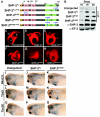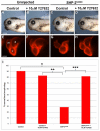SHP-2 acts via ROCK to regulate the cardiac actin cytoskeleton
- PMID: 22278918
- PMCID: PMC3274356
- DOI: 10.1242/dev.067579
SHP-2 acts via ROCK to regulate the cardiac actin cytoskeleton
Abstract
Noonan syndrome is one of the most common causes of human congenital heart disease and is frequently associated with missense mutations in the protein phosphatase SHP-2. Interestingly, patients with acute myelogenous leukemia (AML), acute lymphoblastic leukemia (ALL), juvenile myelomonocytic leukemia (JMML) and LEOPARD syndrome frequently carry a second, somatically introduced subset of missense mutations in SHP-2. To determine the cellular and molecular mechanisms by which SHP-2 regulates heart development and, thus, understand how Noonan-associated mutations affect cardiogenesis, we introduced SHP-2 encoding the most prevalent Noonan syndrome and JMML mutations into Xenopus embryos. Resulting embryos show a direct relationship between a Noonan SHP-2 mutation and its ability to cause cardiac defects in Xenopus; embryos expressing Noonan SHP-2 mutations exhibit morphologically abnormal hearts, whereas those expressing an SHP-2 JMML-associated mutation do not. Our studies indicate that the cardiac defects associated with the introduction of the Noonan-associated SHP-2 mutations are coupled with a delay or arrest of the cardiac cell cycle in M-phase and a failure of cardiomyocyte progenitors to incorporate into the developing heart. We show that these defects are a result of an underlying malformation in the formation and polarity of cardiac actin fibers and F-actin deposition. We show that these defects can be rescued in culture and in embryos through the inhibition of the Rho-associated, coiled-coil-containing protein kinase 1 (ROCK), thus demonstrating a direct relationship between SHP-2(N308D) and ROCK activation in the developing heart.
Figures







References
-
- Ahuja P., Perriard E., Pedrazzini T., Satoh S., Perriard J. C., Ehler E. (2007). Re-expression of proteins involved in cytokinesis during cardiac hypertrophy. Exp. Cell Res. 313, 1270–1283 - PubMed
-
- Arber S., Barbayannis F. A., Hanser H., Schneider C., Stanyon C. A., Bernard O., Caroni P. (1998). Regulation of actin dynamics through phosphorylation of cofilin by LIM-kinase. Nature 393, 805–809 - PubMed
-
- Bentires-Alj M., Paez J. G., David F. S., Keilhack H., Halmos B., Naoki K., Maris J. M., Richardson A., Bardelli A., Sugarbaker D. J., et al. (2004). Activating mutations of the noonan syndrome-associated SHP2/PTPN11 gene in human solid tumors and adult acute myelogenous leukemia. Cancer Res. 64, 8816–8820 - PubMed
Publication types
MeSH terms
Substances
Grants and funding
LinkOut - more resources
Full Text Sources

